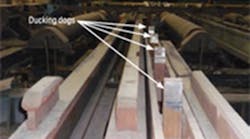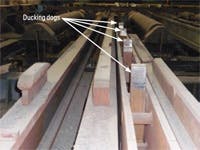Appeared in print as "Closed-loop system boosts machine productivity"
Steel Dynamics Inc., Fort Wayne, Ind., the nation’s fifth largest producer of carbon steel products, was looking to substantially improve the efficiency of a continuous I-beam caster at its operations in Columbia City, Ind. A pusher table that carries formed I-beams away from the caster was malfunctioning periodically and causing downtime for the whole operation. The jamming was caused by the fact that its ducking dogs, pusher arms (powered by hydraulic cylinders) that moved the beams, Figure 1, were not operating precisely in lock step. If the positioning of the dogs was out of step even by a small amount, the beams would get twisted on the table, and the old controls that operated the dog mechanism couldn’t straighten them out. To fix the problem, plant managers called in hydraulics system integrator Hartsock Industrial, Brownsburg, Ind., to upgrade the motion controls for the line.
The old pusher table used open-loop controls that responded to operator inputs simply by operating all hydraulic valves simultaneously. A controlling PLC would issue an identical reference command to each valve, theoretically causing cylinders to push the beams at uniform velocity. In reality, the cylinders’ piston rods moved at different speeds due to variable hose lengths, system friction, and piston blow-by in the cylinders. Pressure transducers were used to signal that the end of the cylinder stroke had been reached, and the PLC would hold the valve open until the end of travel was detected by a pressure spike. This scenario contributed to a decrease in the life of cylinders and pumps. And because there was no feedback based on the position of the beams taken into consideration, there would be no way for the control system to detect a set of dogs lagging behind.
Controller-sensor combo provides solution
The solution was to replace the old open-loop controls with a programmable closed-loop electrohydraulic motion controller and connect the controller to a position-measuring sensor and a proportional servo-quality hydraulic valve to precisely operate each group of dogs. (The system contains six 6-in bore, 63-in. stroke custom mill type pusher cylinders, and each is connected to a set of dogs that are aligned as shown in Figure 1).
To fill these requirements, Hartsock officials specified an RMC 150 multi-axis motion controller from Delta Computer Systems, Battle Ground, Wash. For cylinder position sensing, Hartsock mounted a G-series Temposonics magnetostrictive linear displacement transducer (LDT) from MTS Sensors Inc., Cary, N.C. in each cylinder and connected each cylinder to an Atos SpA
To program the motion controller, Hartsock called in Stoeller Automation of Frankfort, Ind. Stoeller’s engineer Greg Crisp synchronized the motion of the dogs using the special synchronization function built into the RMC controller. With the new controls, one set of dogs becomes a master axis and the others are automatically controlled to move in lock step with it (each Delta RMC is capable of controlling and synchronizing up to eight motion axes). The RMC 150 multi-axis motion controller senses if any dog lags behind and compensates automatically to within a tolerance of ±0.125 in. Tuning of the control loop was facilitated by Delta’s RMCTools autotuning software that includes a visual tool that plots the actual motion of each axis versus its target to ensure that the axis is tuned correctly.
Another problem with the old system was premature cylinder failure from high hydraulic oil temperature created by radiant heat from the beams sitting on the pusher table. FloDraulic updated the cylinders with a check valve in the piston to allow the oil in the cylinder to be returned to the tank between operations instead of bring trapped in the hose lines. Water-cooled jackets were also installed on the bodies of the cylinders. Both measures helped lower the oil temperature and extended the life of system components.
“Prior to implementing this solution, Steel Dynamics was suffering extended downtime due to mis-positioned beams and high maintenance cost related to cylinder and pump failures,” explained Andy Hartsock, president, Hartsock Industrial. “Using multi-axis motion controllers from Delta and MTS’s position feedback technology, we were able to fix these issues and achieve nearly 100% equipment uptime — improving both efficiency and safety in the manufacturing process, and making it possible to expand from a three-strand to four-strand caster.”
The application has gained the attention of the Maintenance and Reliability Committee of the Association of Iron and Steel Technology, where it was nominated for an award due to measurable improvements of uptime and reduction of maintenance costs.
For more information, e-mail [email protected] or visit www.hartsockis.com.
For information on Delta Computer Systems, e-mail bsavela@deltamotion. com or visit www.deltamotion.com.
For information on MTS Sensors, email [email protected] or visit www.mtssensors.com.
To view a video of the pusher table in action, go to bit.ly/HP0811Steel.


